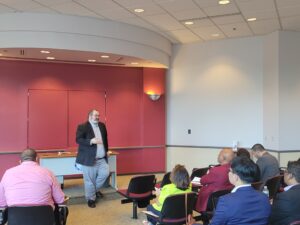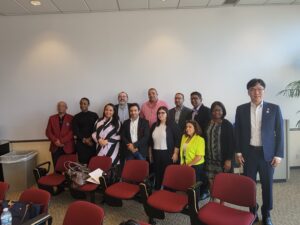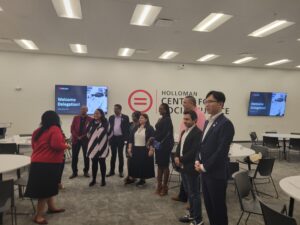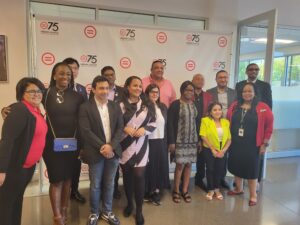Cincinnati: A Transparent City Part 2

Last week, we introduced our delegates from the African Union, Albania, Egypt, Eritrea, Saudi Arabia, Sri Lanka, Taiwan, Trinidad and Tobago, Tunisia, and Zimbabwe. In Cincinnati: A Transparent City Part 1, we discussed why it is so important to study the recent struggles Cincinnati faced around transparency and accountability.
In this post, we will discuss explore the mechanisms used to ensure transparency and accountability in local government. Cincinnati has struggled with this in the past, but by utilizing the tools available the local government can move forward in a way that builds trust with the community.
In part one, we explored the Office of Performance and Data and Analytics as one tool for the city government. Below, we will explore the Office of Ethics and Good Government and the Community Partnering Center.
Office of Ethics and Good Government
In this meeting, delegates got a historical overview of corruption in Cincinnati. The issues we face today are not new. In the 1920’s, Cincinnati’s Mayor ran the city by proxy because he lived in New York. While we might think that’s crazy and could never happen today, it sets the tone for the corruption cases which we saw happen in 2020. In November 2020, the front-runner in the mayoral race was arrested for accepting $40,000 in bribes, becoming the third Cincinnati City Council Member to be arrested on federal corruption charges. He was finally convicted in July 2023 and sentenced just a few months later.
So how do we move on from this?

Christopher Liu, Chief Counsel, speaking to delegates
The Office of Ethics and Good Government created a process prohibiting developers from donating campaign money while their projects are pending with the City Council. This Temporary Prohibition List is also available to the public. Once a developer’s project has been voted on, then money can be donated. They also created a hotline where waste, fraud, or abuse can be reported either by an online form or on the phone. These are then submitted for an internal investigation and can be referred out to the Ohio Ethics Commission.
The delegates were intrigued by this process and the importance of referring it out for a third party. Christopher Liu, Chief Counsel, explained that these measures create trust with the community. Community perception is everything. The community does not want to be deceived by those that ran.
Using Neighborhood Summits to listen to the community and get ideas from them assures people that the city is open and willing to find and correct bad situations.

Delegates with Christopher Liu, Chief Counsel of the Office of Ethics and Good Government
It was surprising to the delegates that the Code of Conduct created by the Council Members, their staff, the Mayor, and the City Manager is self-imposed. Liu explained, this is their contract with the City and the community members. Many of the local government ran on the platform of holding themselves to a higher standard than those that had come before them. The delegates learned that by doing so, it was another reminder to the City government will be held accountable for their actions by the community. If they are not held publicly responsible, then they can be removed from office and the chance of being reelected is slim.
This meeting was incredibly interesting for the delegates to learn how the city government had created an office specifically to ensure transparency and accountability.
Christopher Liu, Chief Counsel, said after the program,
“It’s useful to hear people talk about solutions that have worked for them. It’s also useful to gain a broader perspective on our own best practices.”
Urban League of Greater Southwestern Ohio—The Community Partnering Center
This was undoubtedly the meeting that made the biggest impression on the delegates. The delegates were welcomed by senior team members including Christie Bryant Kuhns, President and CEO, Ebony Young, Senior Vice President of Impact, and Gabriel Fletcher, Managing Director for the Center for Social Justice.
The Social Justice Center was created out of necessity during the 2020 civil unrest. Their work builds upon the work of the Community Partnering Center, which builds community capacity to address issues of crime, disorder, and quality of life in Greater Cincinnati neighborhoods. CPC works with community residents and stakeholders, including the Cincinnati Police Department to create safer neighborhoods.

Charlotte Harris, of the Urban League of Southwestern Ohio, speaking to delegates at UGLSO’s new Center for Social Justice
The Community Partnering Center works within communities affected by gun violence. They use evidence-based information to create lifestyle changes through workforce and financial development. They know it is important to meet people where they are. Their goal is to affect the quality of life by being pro-active. In doing so, they prevent negative interactions between individuals and the police.
Fortunately, the Cincinnati Police Chiefs are very open and receptive to working with the Community Partnering Center. They have welcomed the Community Partnering Center to help them with policy problem solving. In the past, the City of Cincinnati signed the Collaborative Agreement which declares Community Problem-Oriented Policing would be the strategy for police services in the city. The goal of the Urban League is to ensure that the community are just as involved. The Cincinnati Police and the Community partnering Center both understand that it is the residents who will make these efforts sustainable.
Anti-black racism is an American export, according to the delegates. One delegate spoke of the issues that she had observed in the Caribbean country of Trinidad and Tobago. Young men who were viewed as “more white” treated far less harshly than the urban, poorer, Afro-Trinidadian boys who were thrown to the ground and harshly punished. However, not all police violence in the Caribbean is racism. The colonial/post-colonial struggle against white supremacy has left an indelible mark upon the community. Unfortunately, the result is the same.

Many of the delegates were interested in how to bring Collaborative Agreements to their own countries. They were interested in how to convince the police to engage positively. This is where the delegates and the Community Partnering Center look to collaborate in the future, creating systems for police and community engagement and education.
Conclusion
These types of collaboration are very important when creating transparency and accountability for local government. It is the community to whom the city answers. It is community engagement, collaboration, and conversation that is the backbone of our city government.
Cincinnati has many mechanisms for transparency. These are just a few that have been mentioned in these posts.
We would like to thank our community resources for meeting with our international visitors. Your participation makes these programs a success.


